I didn’t have high expectations for Valve’s Steam Deck, given the company’s track record in the hardware space with Steam Machines, Steam Link and the Steam Controller.
I assumed the portable would be glitch-filled, game compatibility would be hit or miss, and the dream of turning the portable into the ultimate emulator machine would be far too difficult. It turns out that, for the most part, I was correct, but that’s not the full story.
Buried beneath the Steam Deck’s myriad shortcomings is one of the most capable handheld video game consoles ever — just be prepared to take on the role of a beta tester.
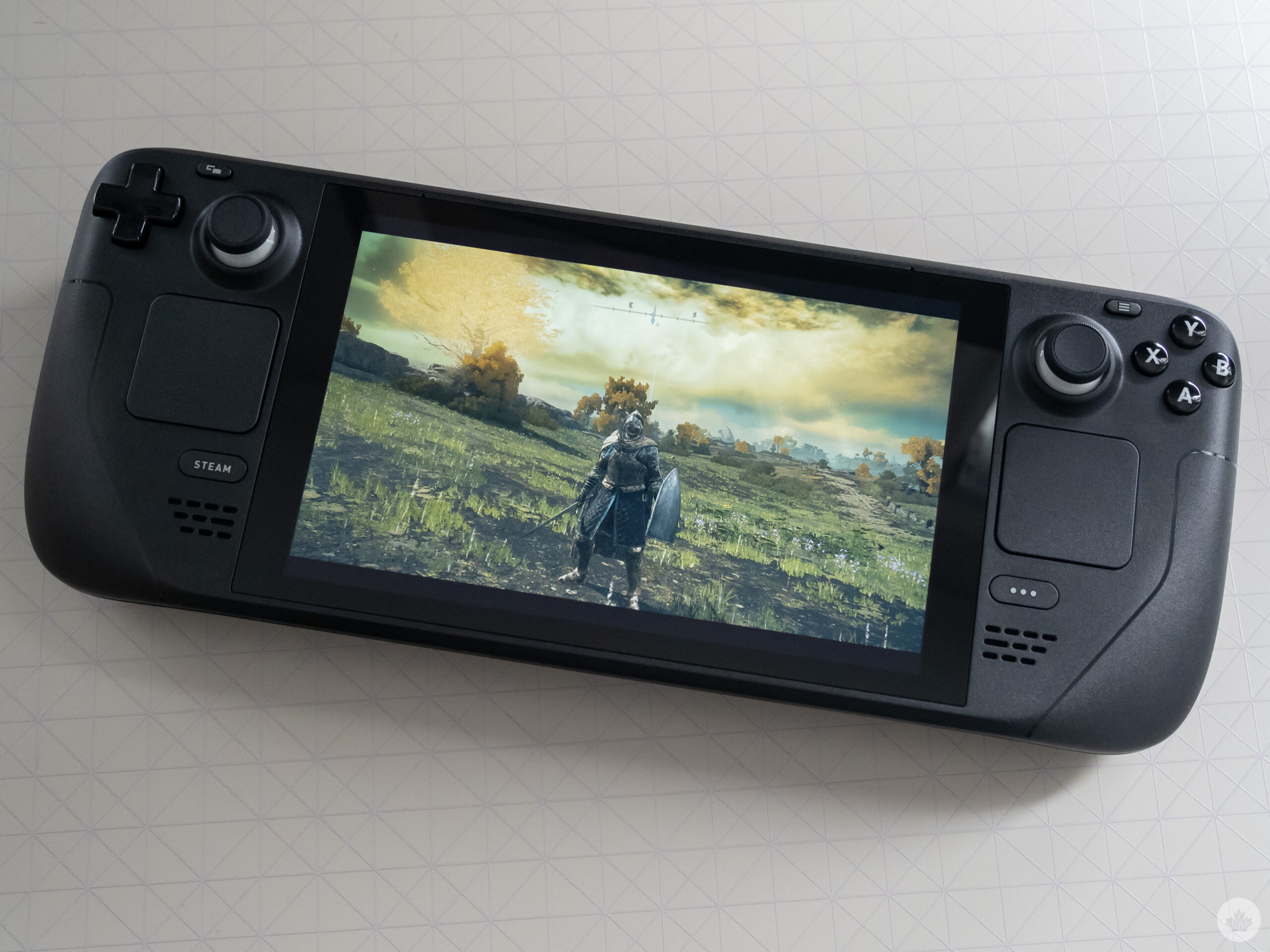
With this in mind, if you go into the Steam Deck with appropriate expectations and understand that it’s a handheld designed for PC gamers (this isn’t the plug-and-play Nintendo Switch), you’ll walk away very impressed with what Valve has accomplished.
In fact, if the Steam Deck continues to improve on the game compatibility front, I might go so far as to say I prefer it over the Switch.
Be prepared to experiment
My journey with the Steam Deck started back in late February, roughly around when Elden Ring released. Ahead of getting my hands on the Deck, I’d read FromSoftware’s latest runs reasonably well on the handheld, albeit with a few performance hiccups, so I was eager to test it out. To my surprise, Elden Ring played solidly on the Steam Deck even at high graphics settings, though I did experience occasional bouts of lag. It’s also worth mentioning that while I’ve recently fallen off playing Elden Ring, I’m shocked at the amount of fun I’ve had with the game, especially considering I typically have no interest in the ultra-difficult ‘Soulsborne’ genre.
Thankfully, Elden Ring‘s performance issues were solved by joining Proton’s ‘bleeding-edge experimental‘ branch of updates, giving access to the game’s latest compatibility layer courtesy of Valve (Proton is the translation layer that allows Windows games to run on Valve’s Linux-powered SteamOS). This update eventually made its way to the standard version of SteamOS roughly a week later.
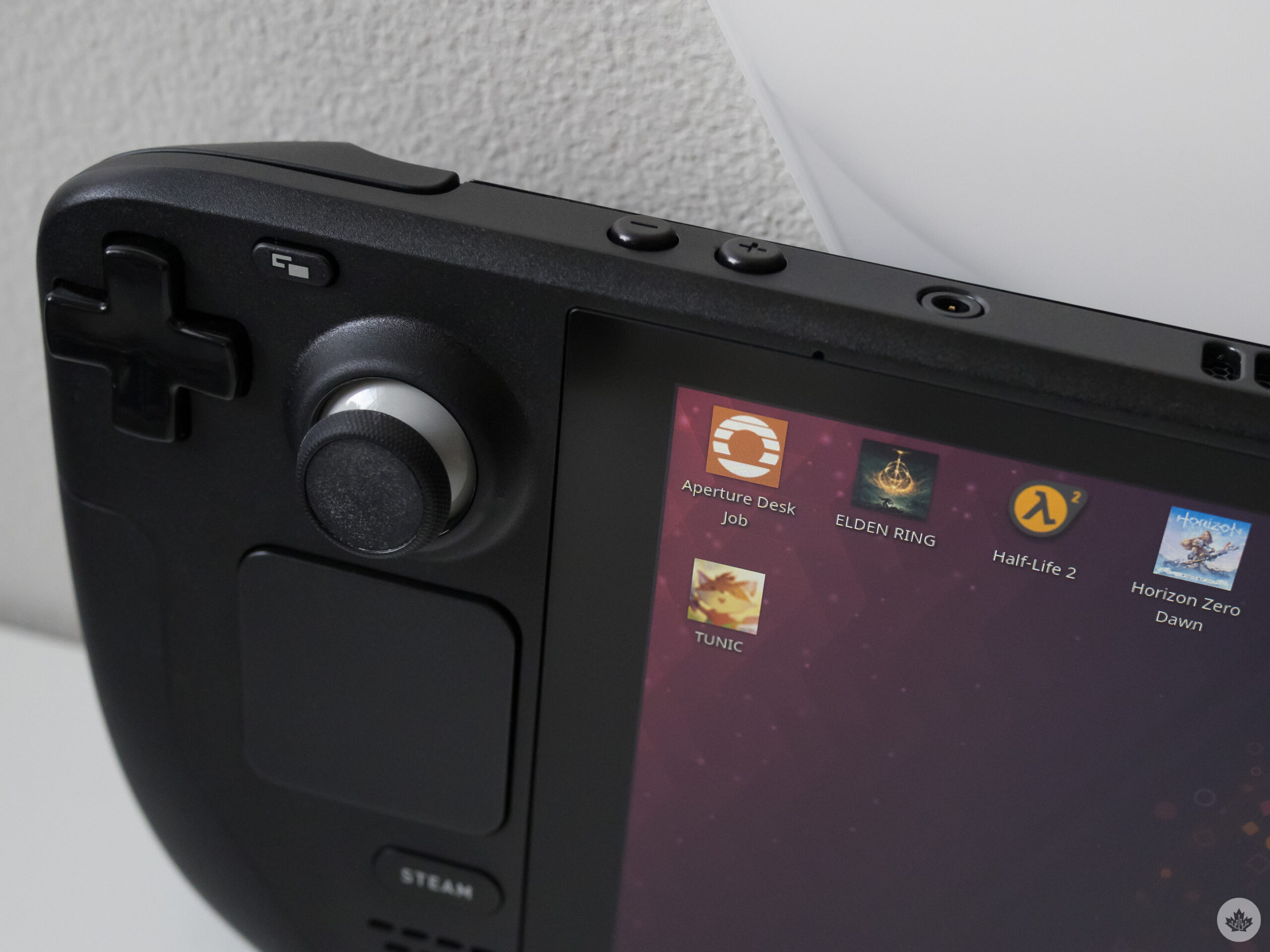
I mention my experience with Elden Ring because it’s the first example of the Steam Deck’s very work-in-progress nature that I encountered. Updates come fast and almost daily, but this also means progress is quick. An issue you’re experiencing with the Deck’s software one day might be fixed the next morning. For example, I was initially unable to format my microSD card to the Steam Deck’s Linux-based ext4 file system, only to have it work the next day after installing the latest SteamOS update. I’ve never used hardware that’s as fluid as this.
Still, even when Elden Ring wasn’t running perfectly on the Deck, I found it difficult not to marvel that I was playing a recently released, modern game on a handheld — something I’ve dreamed of doing since I was a child and first picked up the OG Game Boy.
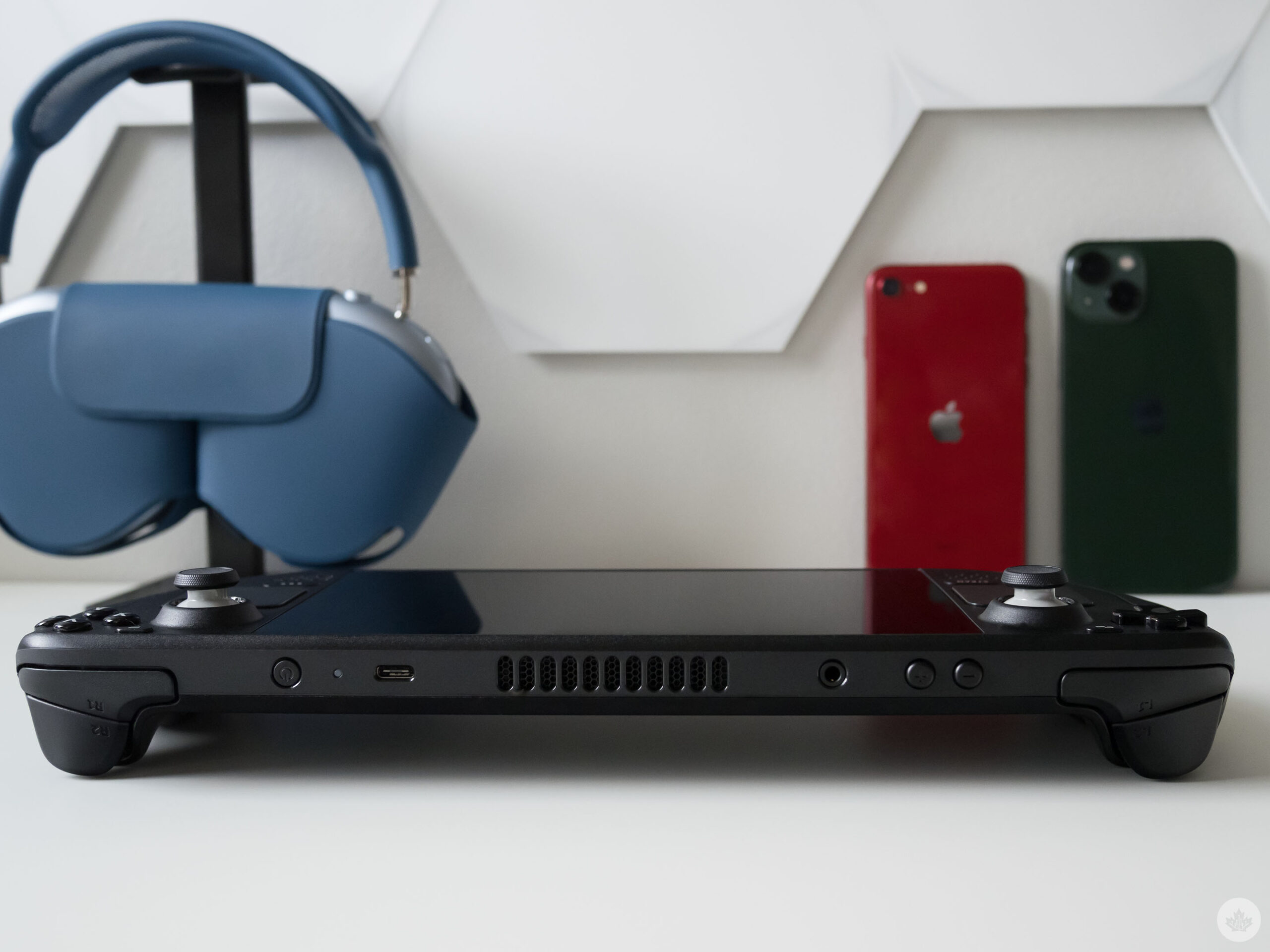
Valve’s ‘Steam Deck Verified’ system makes it relatively easy to figure out what titles are optimized for the handheld while browsing the Steam store. During my time with the Steam Deck, I’ve played Horizon Zero Dawn (I ran into some slowdown during certain open-world areas), Tunic, Half-Life 2, Left 4 Dead, Portal and more, and the experience has been very solid.
Even games that aren’t listed as ‘Verified’ tend to work relatively well on Steam Deck if you’re willing to spend a bit of time on setting up the controls. However, as a primarily console gamer, my Steam library isn’t very extensive, and I haven’t yet spent a lot of time adjusting controls beyond Jet Set Radio.
There are also several easy-to-access, PC-like Steam Deck settings related to GPU clock frequency, thermal power, limiting the frame rate, scaling filters and more, that can come in handy if a game is pushing the Deck just a little too hard. Of course, some people may find these settings intimidating to play around with, but I was able to grasp what most of them do with a little research.

The setting I find myself shifting around the most is the frame rate limiter. For example, I limit Elden Ring to 30fps because it tends to run far more solidly at that frame rate, but bump Tunic up to 60fps because it’s less resource-intensive title.
Big and beautiful
The Steam Deck is massive, especially when you place it beside Nintendo’s Switch. It’s also weighty at 669g, making it difficult to hold up if you’re playing while laying down or not resting the device on a table. That said, the Deck is comfortable in an ergonomic sense thanks to its rear arms that make gripping the handheld easier than a device like the Switch. They help give the deck a more video game controller-like feel.
Most of its buttons and joysticks feel high-quality, though there are a few notable exceptions. For example, the two touch panels flanking on either side of the Steam Deck have a decidedly cheap feel to them alongside wonky haptics I’d describe as passable, but far from great (especially when compared to the Switch’s ‘HD Rumble.’ Thankfully, I rarely touch these pads unless I’m using the right one as a mouse replacement in desktop mode. However, the Deck’s haptics are much better in the handheld’s triggers.
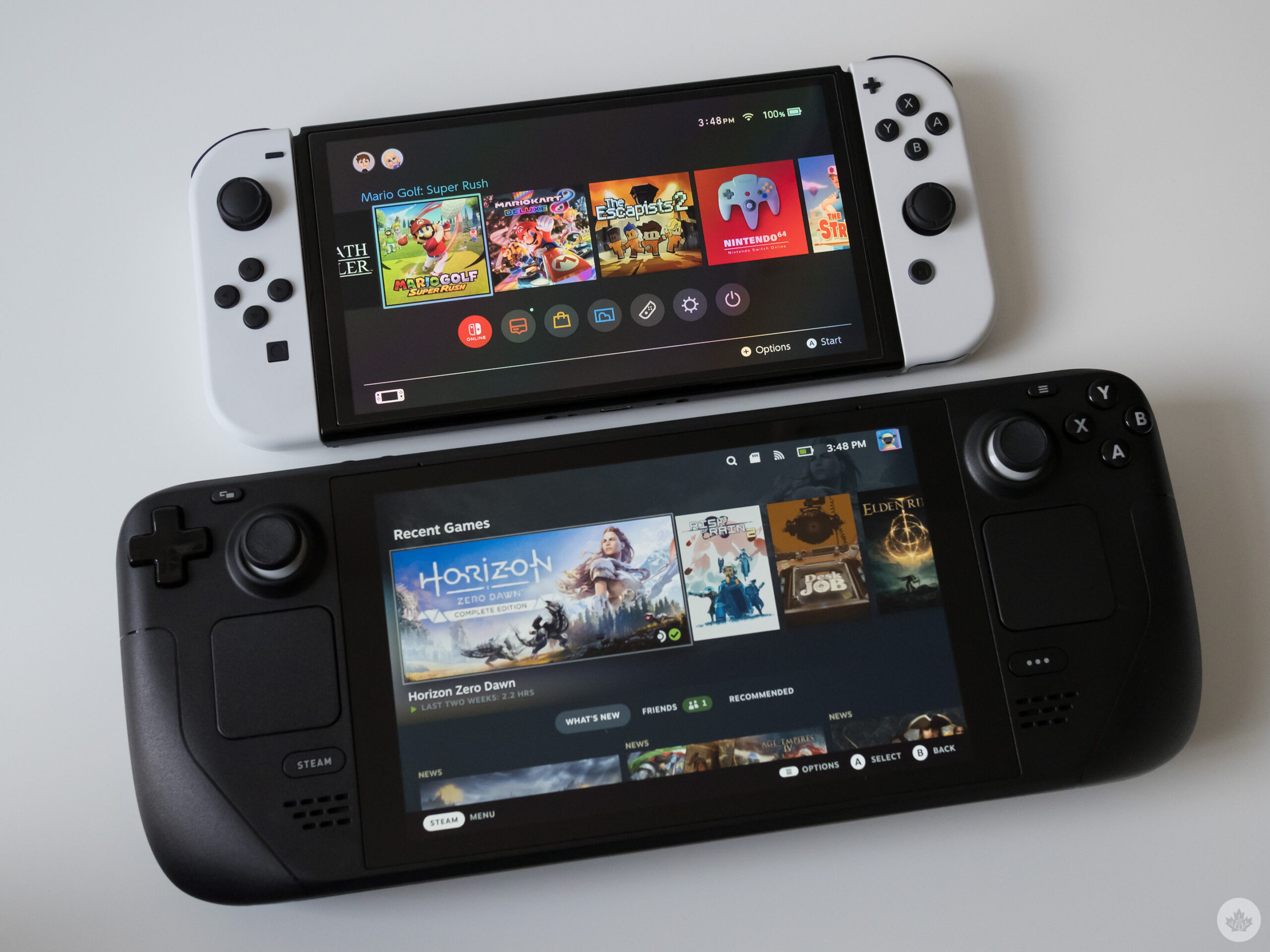
In that same vein, the d-pad is in an awkward position that’s difficult to reach, and as primarily an Xbox player, the parallel, PlayStation-like joysticks feel a little strange to me. To be fair, I did get used to them after a few hours. There are also four back buttons on the rear of the deck that I’ve never used and wish weren’t there at all since this would make its rear arms smoother and easier to grip.
My big takeaway from the Steam Deck’s design is that while the device is heavy and a little bulky, I’ve found it far more comfortable to use for long play sessions than the Nintendo Switch, though, of course, this will vary based on the size of your hands and personal preference.
Things are a little more disappointing on the display front. The Steam Deck’s 7-inch LCD 1280 x 800 pixel resolution screen may measure in at the same size as the Switch OLED model’s 7-inch 1280 x 720 pixel resolution panel, but its colour reproduction, vibrancy and surprisingly chunky bezels can’t compete with Nintendo’s OLED handheld. The Steam Deck’s LCD screen doesn’t look bad, but mid-range smartphones and even the base model Switch feature a better display.
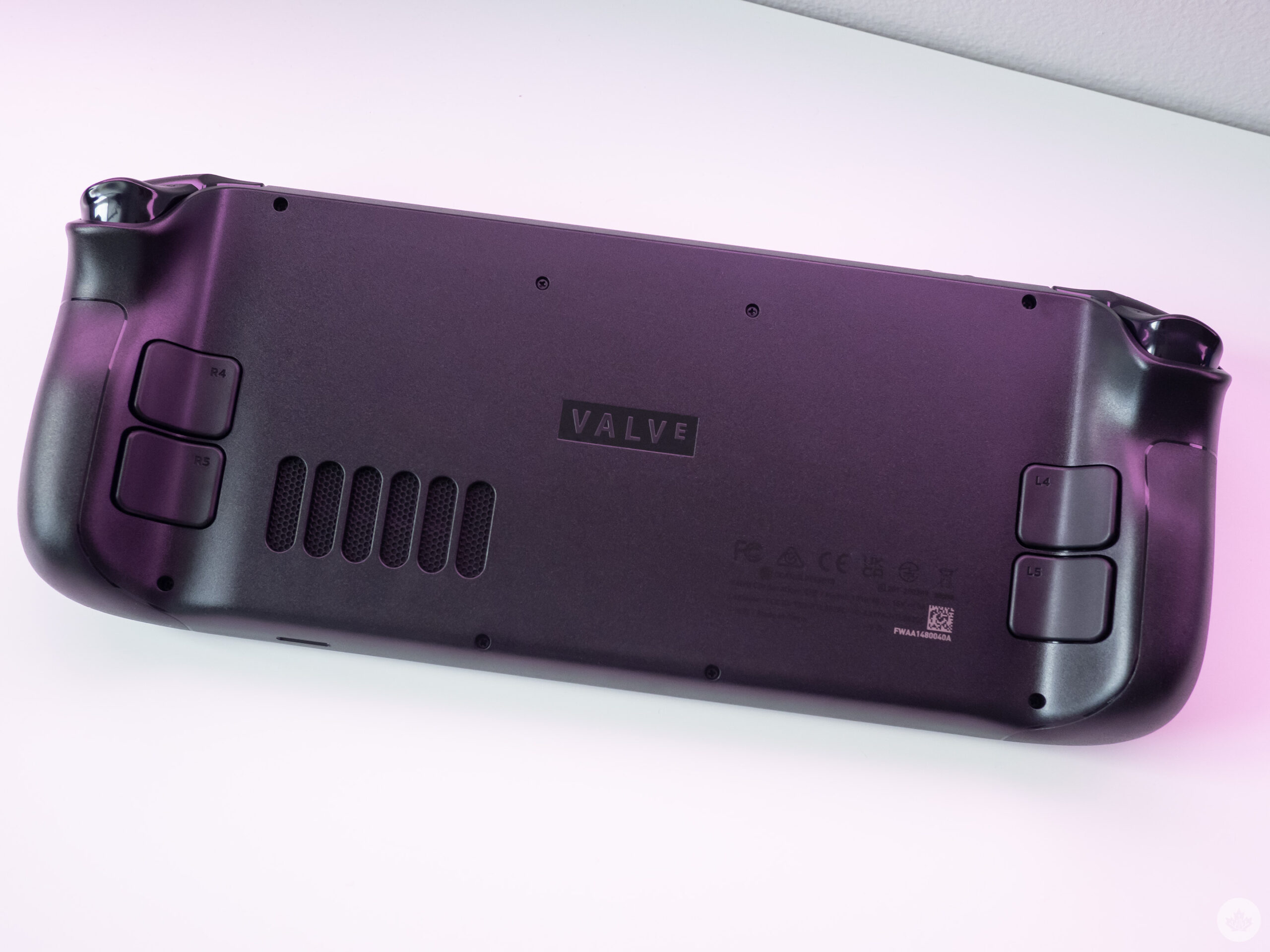
And if you think you can bypass the handheld’s screen and connect directly to a television or monitor for a better experience, you’re half correct. While you can do this with nearly any powered USB-C cable or dongle that supports video out (I used the Genki Covert Switch Dock), your output resolution is stuck at 1280 x 800 when it comes to actually playing games. The resolution of SteamOS’ UI will upscale all the way to 4K, though.
As a side note, the Steam Deck’s included hard case absolutely slaps. It makes me less afraid to take the beast of a portable machine outside of my home, and overall, is probably one of the most solid handheld gaming device cases I’ve ever used (and I’ve used dozens over the years).
Work-in-progress
This is where my ongoing journey with the device comes in again. If you want to use platforms like Xbox Cloud Gaming, install emulators or run any app/software that isn’t available directly through SteamOS on the Steam Deck, prepare to spend ample time figuring things out. For example, while Xbox Cloud Gaming runs on the handheld and gives access to hundreds of titles through Xbox Game Pass Ultimate streamed directly over the internet to the device, there’s a multi-step process to get it running.
The same can be said about emulators and ROMs. Thanks to EmuDeck, an app that automatically configures various emulators for the Steam Deck, the process is far simpler than it was a few weeks ago. For the most part, EmuDeck does everything for you, but it still takes several steps, including formatting an SD card (you can also store ROMs on internal storage), creating SteamOS shortcuts and more, before you’ll be playing N64 classic 1080° on your Deck.
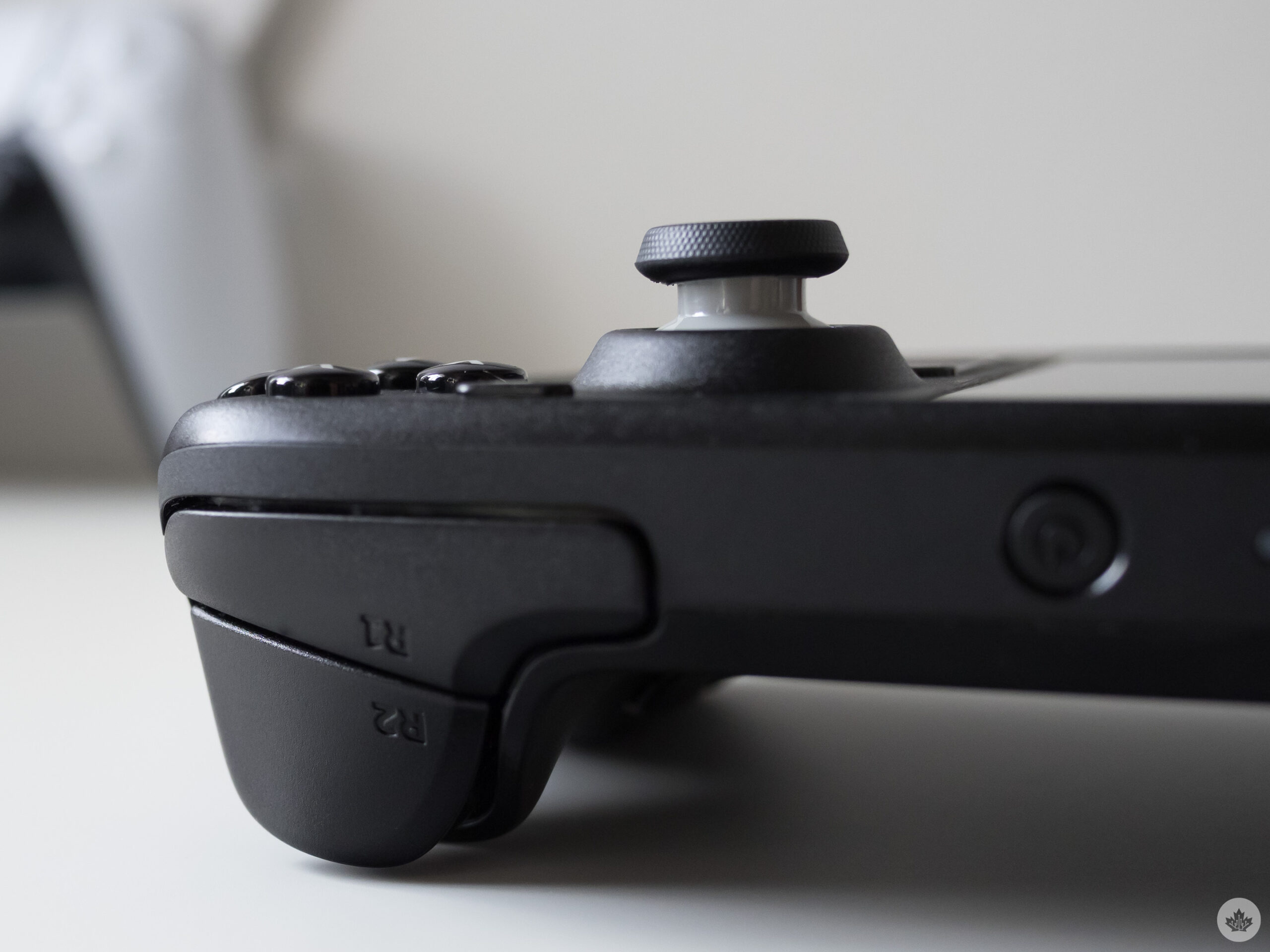
I’d recommend going the Emulation Station route rather than creating shortcuts to specific ROMs directly in SteamOS because it looks cleaner and is easier to set up. After spending a weekend turning the Steam Deck into the ultimate retro emulation device, I’d argue that it’s worth the effort, but the setup isn’t as straightforward of a process as some guides make it out to be.
Then there’s desktop mode. While I was initially very frustrated with the Steam Deck’s desktop mode — for example, at one point there wasn’t an easy-to-access on-screen keyboard — the operating system and its capabilities have improved significantly over the past few weeks.
Navigating with the right trackpad as your mouse pointer works relatively okay, but clicking the left or right pad doesn’t always work reliably and can often feel inaccurate. Adding to the awkwardness, pulling up the on-screen keyboard isn’t contextual like a smartphone and requires you to press the Steam button and X simultaneously top open and close it.

Navigation gets easier if you use a wireless mouse and keyboard with the Steam Deck instead. In my case, I use a USB-C-to-A adapter with a Logitech wireless dongle plugged into it to easily jump from using my MacBook Pro to the Steam Deck. Though some people may want to avoid desktop mode entirely, if you plan to delve into the platform’s intricacies and install apps from its ‘Discover’ store, you’ll need to use it.
It’s also worth mentioning that the Steam Deck’s battery life can be abysmal. There were instances where I only managed to get 1.5 to 2 hours out of the handheld and opted to just game away with it plugged in. It depends on what game you’re playing, however. For example, with Tunic, I was getting in the range of four hours, and when I started to mess around with emulators (Crazy Taxi for the Dreamcast has aged remarkably well), I was getting upwards of four hours.
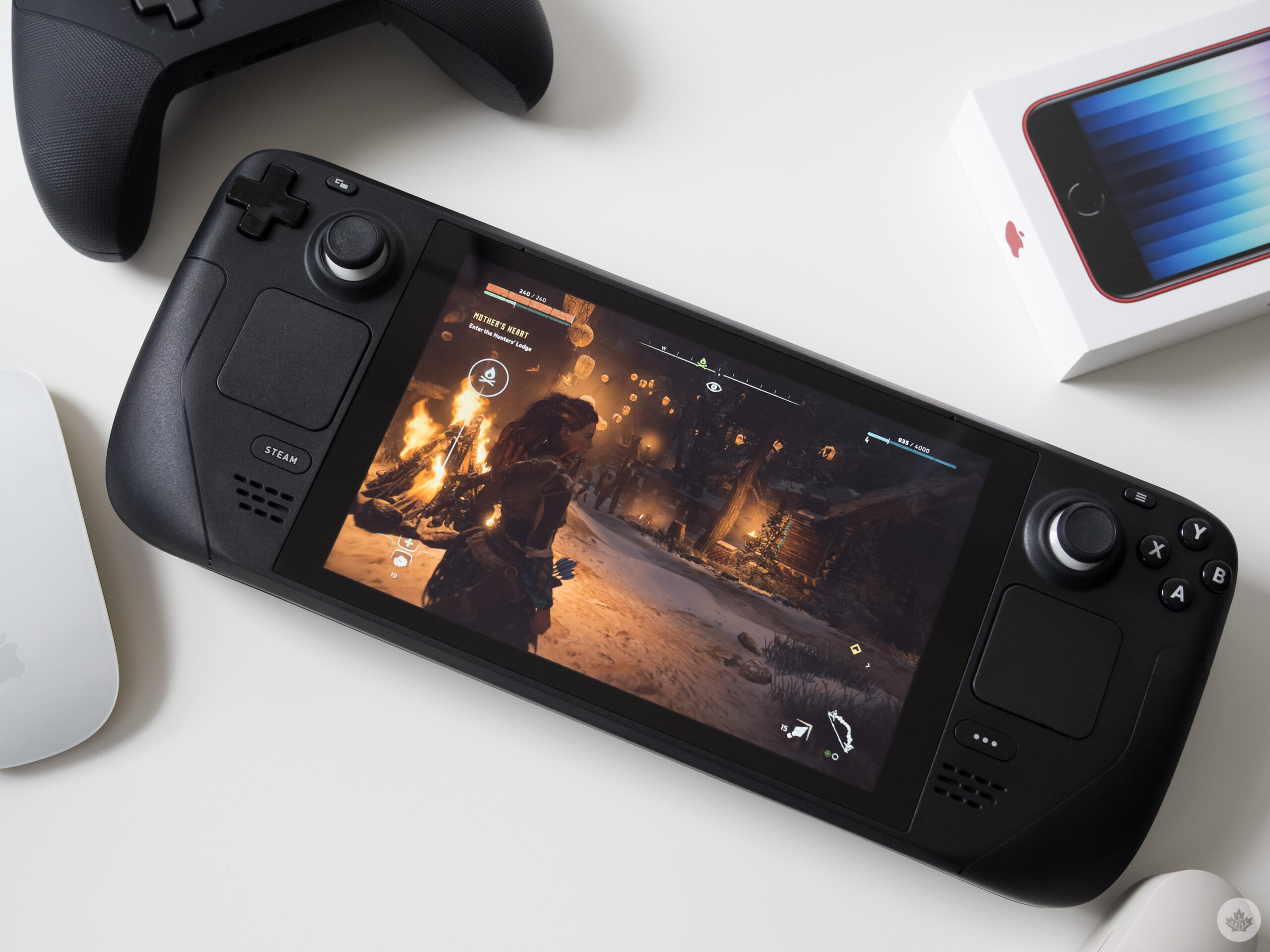
And finally, there’s the fan. The Steam Deck’s very loud fan is my most significant issue with the device. It’s running nearly all the time regardless of what game you’re playing, and is so loud that, for example, my partner laying beside me in bed can hear it clearly. This led me to use headphones with the handheld in most situations.
Some people may have less of an issue with the low-pitched whine, but I despise it. I’m hoping this is a problem Valve irons out in future versions of the Steam Deck.
Still to come
I’ve praised the Steam Deck’s game compatibility a lot in this story, but it’s also lacklustre in some respects. For example, Windows can’t easily be installed on Valve’s handheld, though Windows 11 support recently came to the platform (previously, only Windows 10 worked because of the lack of support for the Deck’s TPM module).
Further, some Windows drivers are still missing, and an installation requires you to entirely wipe SteamOS from the device since there’s not yet a dual boot option. Plus, navigating Windows with the Steam Deck’s built-in buttons is reportedly a chore.
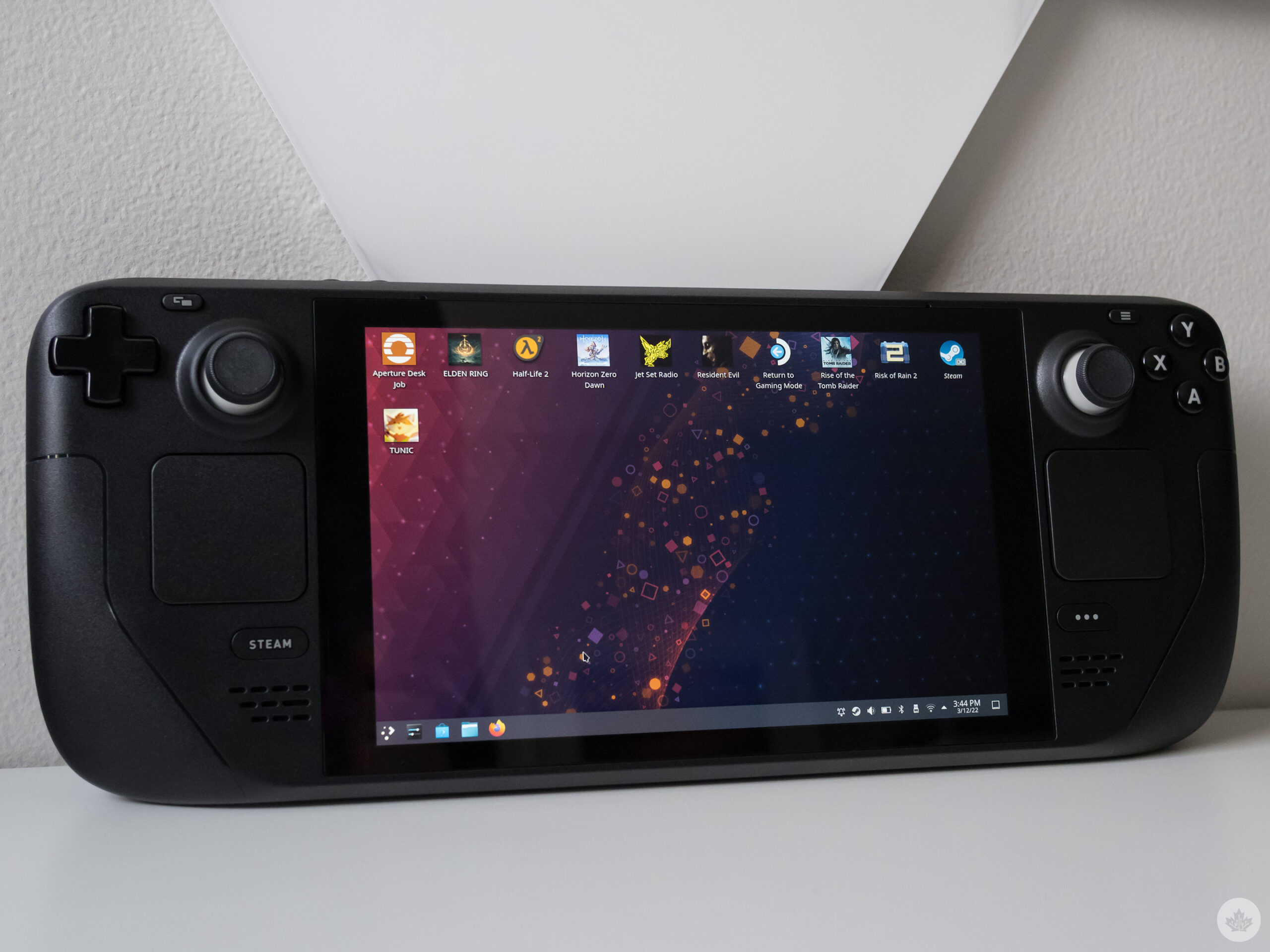
On the other hand, installing Windows gives you access to Xbox Game Pass titles, Destiny 2, Fortnite and other games that aren’t available directly through Steam. As you likely already guessed, I haven’t taken Windows for a spin on the Steam Deck and likely won’t until a dual-boot option becomes available.
Now that you’ve read this story, you’re probably wondering why the headline is so positive despite the Steam Deck having so many issues. The handheld really is a hardware achievement on Valve’s part and, in a sense, feels like the Switch Pro that still hasn’t materialized. Everything from its versatility and openness to its ability to just straight up play recently released AAA games is impressive.
The current state of the Steam Deck isn’t perfect, but I’m excited to see where Valve takes the device.
The Steam Deck is available on Valve’s website starting at $499, but good luck getting your hands on one if you don’t already have a pre-order. A the time of publication of this story, new Steam Deck orders won’t ship until October 2022.




















